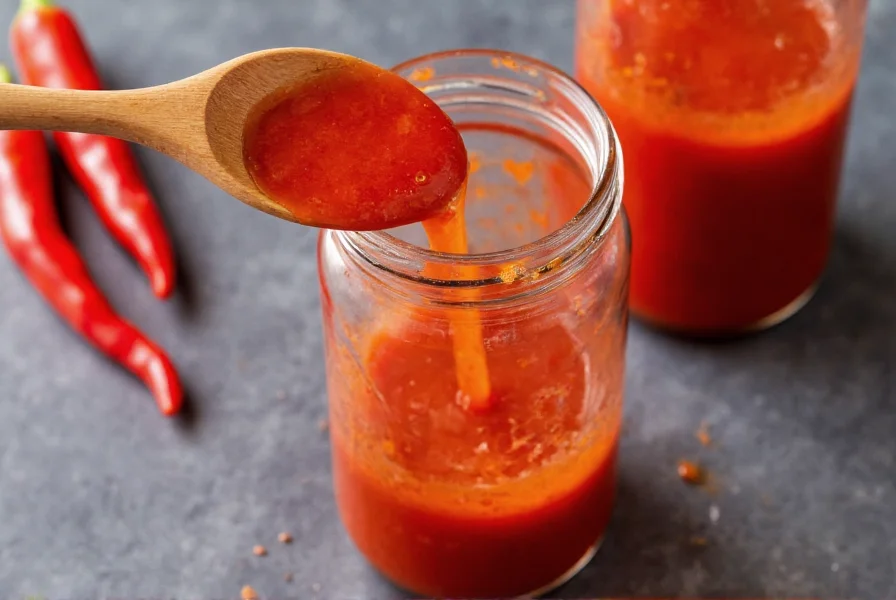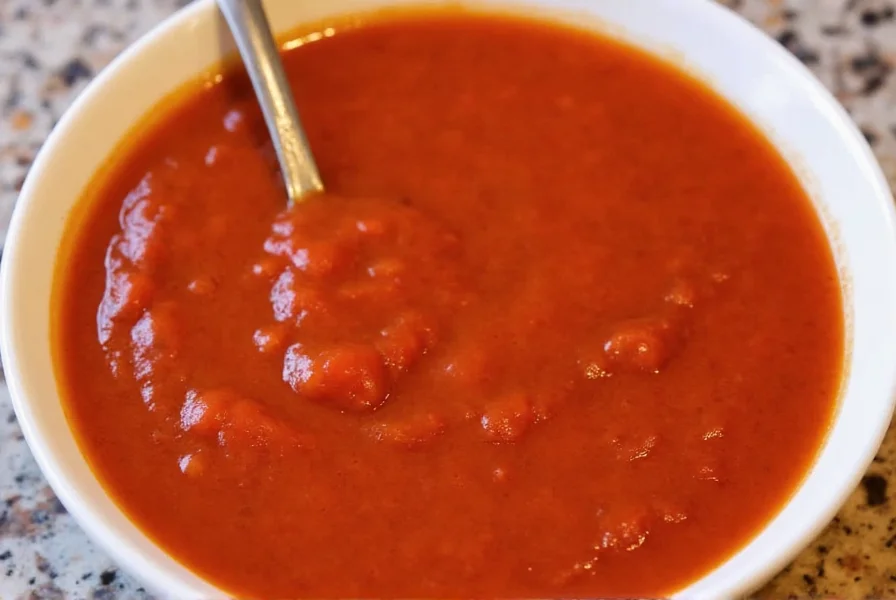The simplest way to make chili sauce is by blending fresh or dried chilies with vinegar, garlic, and salt, then simmering the mixture for 15-20 minutes until thickened. For a basic recipe, combine 1 cup chopped chilies (like red jalapeños or serranos), 1/2 cup vinegar, 2 minced garlic cloves, and 1/2 teaspoon salt in a saucepan. Cook over medium heat until reduced by one-third, then blend until smooth. Adjust spice level and consistency to your preference.
Making chili sauce at home gives you complete control over ingredients and heat level, resulting in a fresher, more vibrant condiment than most store-bought options. Unlike commercial sauces that often contain preservatives and artificial flavors, homemade chili sauce showcases the true character of quality chilies and complementary ingredients. Whether you prefer a fiery Thai-style sauce, a smoky Mexican adobo, or a sweet-and-spicy Asian variation, the basic preparation method remains consistent with minor adjustments for regional preferences.
Essential Ingredients for Perfect Chili Sauce
The foundation of any great chili sauce starts with selecting the right ingredients. Understanding what each component contributes will help you create a balanced sauce tailored to your taste preferences.
Chili Peppers: The Heart of Your Sauce
Choosing your chilies determines both the heat level and flavor profile:
- Mild options: Poblano (1,000-2,000 SHU), Anaheim (500-2,500 SHU), or Bell peppers (0 SHU) for color without heat
- Medium heat: Jalapeño (2,500-8,000 SHU), Serrano (10,000-23,000 SHU), or Fresno (2,500-10,000 SHU)
- High heat: Thai bird chilies (50,000-100,000 SHU), Habanero (100,000-350,000 SHU), or Ghost peppers (855,000-1,041,427 SHU)
For how to make homemade chili sauce with balanced flavor, consider using a combination of chili varieties. A blend of red jalapeños for fruitiness with a small amount of serranos for heat creates a versatile sauce. Always wear gloves when handling hot chilies and avoid touching your face.
Acid Components for Balance and Preservation
Acidity serves multiple purposes in chili sauce preparation:
- Preserves the sauce by creating an inhospitable environment for bacteria
- Enhances the perception of other flavors
- Helps maintain vibrant color
- Provides necessary tang that balances heat
Vinegar is the most common acid used in traditional chili sauce recipes. White distilled vinegar offers clean acidity, while apple cider vinegar adds subtle fruit notes. For authentic Asian-style sauces, rice vinegar works best. The standard ratio is 1/4 to 1/2 cup vinegar per cup of chilies, but you can adjust based on your preservation needs and taste preferences.
Flavor Enhancers
These supporting ingredients transform basic chili mixtures into complex sauces:
| Ingredient | Function | Recommended Amount |
|---|---|---|
| Garlic | Adds depth and pungency | 2-4 cloves per cup of chilies |
| Onion | Provides sweetness and body | 1/4 cup finely chopped per cup of chilies |
| Salt | Enhances all flavors and preserves | 1/2 to 1 teaspoon per cup of chilies |
| Sugar/honey | Counters acidity and heat | 1-2 teaspoons per cup of chilies |
| Lime/lemon juice | Fresh citrus note | 1-2 tablespoons per cup of chilies |
Equipment You'll Need
While you can make chili sauce with basic kitchen tools, having the right equipment ensures better results and safety:
- Medium saucepan with heavy bottom (prevents scorching)
- Immersion blender or regular blender (wear eye protection when blending hot liquids)
- Heatproof spatula
- Fine-mesh strainer (optional, for smoother texture)
- Sterilized glass bottles with airtight lids for storage
- Thermometer (optional, but helpful for precise temperature control)
Step-by-Step Guide to Making Chili Sauce
Follow these detailed instructions for how to make chili sauce that's flavorful, safe, and shelf-stable.
Preparation (15 minutes)
- Wash and dry all produce thoroughly. Wear gloves when handling hot chilies.
- Remove stems from chilies. For milder sauce, remove seeds and white membranes (where most capsaicin resides).
- Chop chilies, garlic, and onion into roughly equal-sized pieces for even cooking.
- Sterilize your storage bottles by boiling for 10 minutes or running through a dishwasher's sanitize cycle.
Cooking Process (25 minutes)
- Combine chilies, vinegar, garlic, onion, salt, and any sweeteners in a saucepan.
- Bring to a gentle simmer over medium heat (do not boil vigorously).
- Reduce heat to low and simmer uncovered for 15-20 minutes, stirring occasionally, until chilies are completely soft and liquid has reduced by about one-third.
- Remove from heat and let cool slightly (5-10 minutes) before blending.
Blending and Finishing (10 minutes)
- Carefully transfer the mixture to a blender, filling no more than halfway. Hold the lid firmly with a towel and start on low speed.
- Blend until completely smooth, about 1-2 minutes.
- For extra-smooth sauce, strain through a fine-mesh sieve, pressing with a spatula to extract all liquid.
- Taste and adjust seasoning—add more salt, vinegar, or sweetener as needed.
- If preserving, return sauce to clean saucepan and heat to 185°F (85°C) before bottling.

Troubleshooting Common Issues
Even with careful preparation, you might encounter these common challenges when learning how to make chili sauce:
Sauce Is Too Thin
If your sauce hasn't thickened sufficiently after simmering:
- Return to heat and simmer uncovered for additional 5-10 minutes
- Add 1 teaspoon of cornstarch mixed with 1 tablespoon cold water per cup of sauce
- Reduce heat and continue simmering until desired consistency
Sauce Is Too Thick
To thin an over-thickened sauce:
- Add small amounts of vinegar or water (1 tablespoon at a time)
- Reheat gently while stirring until properly diluted
- Avoid adding too much liquid, which can dilute flavor
Flavor Imbalance
Adjusting your sauce's flavor profile:
- Too spicy: Add more vinegar, a touch of sugar, or a small amount of tomato paste
- Not spicy enough: Blend in a small amount of fresh hot chilies or cayenne pepper
- Too acidic: Add a pinch of baking soda (1/8 teaspoon at a time) or more sweetener
- Lacking depth: Simmer with additional garlic or a small piece of roasted bell pepper
Storage Guidelines for Homemade Chili Sauce
Proper storage ensures your homemade chili sauce remains safe and flavorful:
Refrigeration
For immediate use (within 1-2 weeks):
- Cool sauce completely before transferring to clean container
- Store in airtight glass container in refrigerator
- Always use clean utensils when serving to prevent contamination
- Consume within 2 weeks for best quality
Long-Term Preservation
For how long does homemade chili sauce last when properly preserved:
- Refrigerator (unprocessed): 2-3 weeks
- Refrigerator (processed): 6-12 months
- Freezer: Up to 1 year
- Room temperature (canned): 1-2 years (only with proper canning techniques)
To safely preserve your sauce for room temperature storage, follow proper canning procedures including water bath processing for 15 minutes. The high acid content from vinegar makes chili sauce suitable for water bath canning, but always follow tested preservation guidelines from reliable sources like the National Center for Home Food Preservation.
Popular Regional Variations
Once you've mastered the basic technique for how to make chili sauce, experiment with these authentic variations:
Asian-Style Chili Sauce
Common in Thai, Vietnamese, and Chinese cuisines:
- Use Thai bird chilies for authentic heat
- Add 1 tablespoon fish sauce for umami
- Include 1 teaspoon grated ginger
- Substitute rice vinegar for white vinegar
- Add 1 tablespoon tamarind paste for complexity
Mexican Salsa Picante
Traditional Mexican-style hot sauce:
- Use a combination of jalapeños and serranos
- Add 1/4 cup roasted tomatoes
- Include 1/2 teaspoon cumin
- Use white vinegar or lime juice
- Add a small piece of roasted garlic for depth
Caribbean Scotch Bonnet Sauce
Tropical hot sauce with fruit notes:
- Use scotch bonnet peppers as primary chili
- Add 1/4 cup mango or pineapple
- Include allspice and thyme for authentic flavor
- Use apple cider vinegar for milder acidity
- Add a pinch of cinnamon for complexity
Creative Ways to Use Your Homemade Chili Sauce
Move beyond just adding heat to dishes with these innovative applications:
- Marinade base for proteins (dilute with oil and citrus)
- Stirred into mayonnaise for spicy aioli
- Added to salad dressings for a flavor boost
- Drizzled over pizza or flatbreads before serving
- Mixed with honey for a sweet-spicy glaze
- Stirred into soups and stews for depth
- Used as a dipping sauce for spring rolls or dumplings
How long does homemade chili sauce last in the refrigerator?
Properly stored in a clean, airtight container, homemade chili sauce will last 2-3 weeks in the refrigerator. Always use clean utensils when serving to prevent contamination. For longer storage, process the sauce through a water bath canning method or freeze it in ice cube trays for up to one year.
Can I adjust the heat level after making chili sauce?
Yes, you can adjust heat after making chili sauce. To reduce heat, add more vinegar, a touch of sugar, or a small amount of tomato paste. To increase heat, blend in additional fresh hot chilies or a pinch of cayenne pepper. Remember to reheat the sauce gently after adjustments and let flavors meld for at least 30 minutes before serving.
What's the best way to preserve homemade chili sauce for long-term storage?
The safest method for long-term storage is water bath canning. Process filled, sealed jars in boiling water for 15 minutes to create a vacuum seal. Alternatively, freeze sauce in ice cube trays then transfer cubes to freezer bags for up to one year. For refrigerator storage (2-3 weeks), ensure the sauce has sufficient acidity (pH below 4.6) from vinegar or citrus juice.
Why did my homemade chili sauce separate?
Separation occurs when oil from chilies or added ingredients rises to the top. This is normal and doesn't indicate spoilage. Simply shake or stir the sauce before use. To minimize separation, ensure thorough blending and consider adding a small amount of xanthan gum (1/8 teaspoon per cup) as a natural stabilizer during the final heating stage.
Can I use dried chilies instead of fresh for making chili sauce?
Yes, dried chilies work well for chili sauce. Rehydrate them by soaking in hot water for 20-30 minutes until soft, then drain before using. Dried chilies often provide more concentrated flavor. Use about one-third the amount of dried chilies compared to fresh, as they're more potent. Ancho, guajillo, and arbol are excellent dried options for complex flavor profiles.











 浙公网安备
33010002000092号
浙公网安备
33010002000092号 浙B2-20120091-4
浙B2-20120091-4